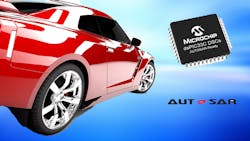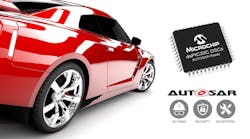Simplify Automotive Designs with AUTOSAR-Ready Devices
For the uninitiated, a quick review: The Automotive Open System Architecture (AUTOSAR) alliance addresses the challenge of increasing software complexity by providing an open industry standard for automotive electronic control units (ECUs). The AUTOSAR Classic Platform architecture distinguishes between three software layers that run on a microcontroller: application, runtime environment (RTE), and basic software (BSW).
Back now to the work-a-day world. Microchip Technology has designated select devices in its dsPIC33C family as AUTOSAR-ready digital signal controllers (DSCs). The supplier is expanding its portfolio to cover the large memory segment with the ISO 26262-compliant dsPIC33CK1024MP7xx family.
This new family has 1-MB flash and enables applications running automotive software such as AUTOSAR, MCAL drivers, ISO 26262 functional-safety diagnostics, and security libraries. The devices include a central processing unit (CPU) with specialized peripherals for general automotive, advanced sensing and control, digital power, and motor-control applications, too.
According to Microchip, the MCAL driver packages for AUTOSAR-ready dsPIC33C DSCs comply with AUTOSAR 4.3.x. The ASIL B- and ASPICE-compliant drivers with full source code are integrated with the EB tresos Studio AUTOSAR configuration tool from Elektrobit. EB tresos Studio lets engineers configure, validate, and generate ECU basic software.
“The AUTOSAR-ready dsPIC33C DSCs enable designers to achieve a high level of system optimization by implementing AUTOSAR-based applications, functional-safety goals, and security use cases in a single microcontroller while meeting robust automotive application requirements,” said Joe Thomsen, vice president of the MCU16 business unit at Microchip Technology. “This opens up a world of opportunities for designers looking to work with Microchip while expanding into e-mobility and advanced sensing and control applications.”
Key Applications and Benefits
The dsPIC33C DSCs are targeted at sensor interfacing; digital power; and motor-control applications for the automotive market including dc-dc systems, on-board chargers (OBCs), actuators and sensors (position, pressure), and other control units aimed at achieving Automotive Safety Integrity Level (ASIL) B or ASIL C.
Microchip has designated select devices in its dsPIC33C family as AUTOSAR-ready DSCs. These devices include dsPIC33CH dual-core DSCs (90+100 MHz) and dsPIC33CK single-core DSCs.
The benefit of adopting AUTOSAR-ready devices is that engineers can improve their risk and complexity management while decreasing development time through reusability.
Those who have previously designed bare-metal or non-AUTOSAR automotive applications and are now adopting AUTOSAR can scale up by staying within the dsPIC33C DSC ecosystem. The AUTOSAR ecosystem for the dsPIC33C DSCs includes MICROSAR Classic from Vector, KSAR OS from KPIT Technologies Ltd., and ASPICE- and ASIL B-compliant MCAL drivers from Microchip.
The new DSCs also feature integrated DSP and analog functionality for sensor-interfacing designs. Furthermore, ISO 26262 and IEC 61508 functional-safety packages contain FMEDA reports, a safety manual, diagnostic libraries, and more.
Development Tools
Software and tools from Microchip include certified MPLAB XC16 compiler functional-safety licenses, the MPLAB X Integrated Development Environment (IDE), MPLAB Code Configurator (MCC), programming and debugging tools, and software libraries and reference code for security use cases. Third-party hardware tools include the TRACE32 debugger from Lauterbach.

